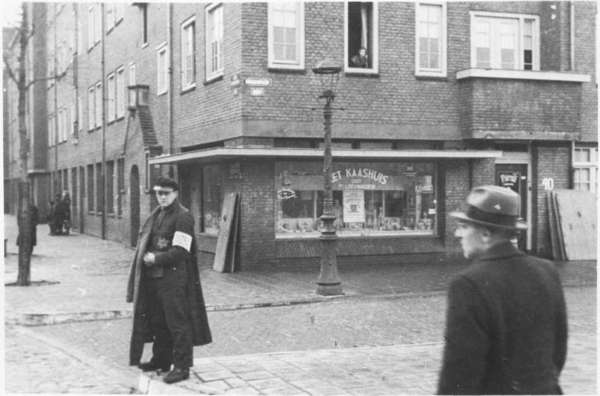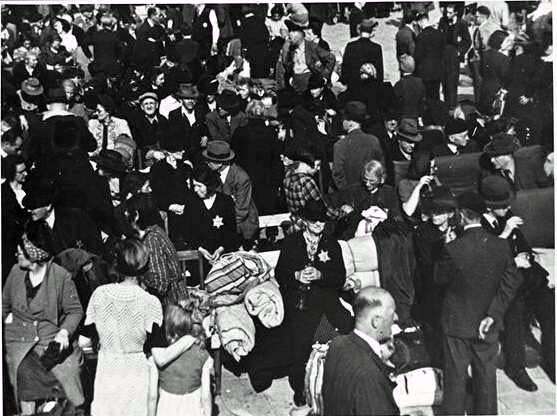Krugerplein, or Kruger Square, in Amsterdam, the Netherlands, is now the theatre of a series of incidents, starting with a woman who hung an Israeli flag outside her window. Muslims answered by displaying “Palestinian” flags.
The woman who hung the Israeli flag, Leah Rabinovitch, is originally from Mexico, and therefore probably may not have been aware of Islamic intolerance towards all things Jewish. Her neighborhood, however, is majority “non-western immigrants,” meaning mostly Muslims.
She received death threats, had stones thrown through her windows, and had a Molotov-cocktail thrown at her home. The corporate owner of her apartment ordered her to remove the flag. Israel’s flag after all, is considered a “provocation.”
Checking at Krugerplein, last week, I counted seven “Palestinian” flags – flags which are never considered a provocation, of course.
The good news is that Israel’s flag is back, again enjoying the Dutch sunlight.
What is revealing, however, is not what happened, but where it happened.
Krugerplein is at the very heart of the Transvaal neighborhood [Transvaalbuurt], built a hundred years ago. The streets are all named after the heroic Boer fighters, who waged a bitter guerrilla war against the colonial superpower of those days, the British empire. The names celebrate the traditional friendship between the Afrikaners/Boers and the Dutch. President Kruger, general Botha, Orange Freestate; they are all there.
In the 1920s and 30s, Jews from the overcrowded center of Amsterdam moved to Transvaalbuurt. In pre-World War II days, it counted 17,000 inhabitants, 70% of them Jewish. There was very little interest in religion. Many of them joined “left-wing” causes. Trade unions, and socialist and communist parties flourished — a Dutch version of the Lower East Side.
Then the Hitler socialists came. The Germans sealed off the neighborhood with barbed wire. They named it Judenviertel II, Jewish Quarter Number Two. It became a ghetto, or better: a death trap. Jews from other parts of the Netherlands were forced to move to Amsterdam, and found refuge in the Transvaalbuurt. Deportations started, July 1942. The Jews were moved to the camps, and gassed.
Older people in the neighborhood can still tell stories. How, as young children, they were told by the Germans to stay away from the windows and not to peek outside when the Jews were marched off to the nearby Muiderpoort train station. Most seniors will still weep after two sentences as they will recall their lost schoolmates, or the kids they played with.
One sunny Sunday, it was all over. On June 20, 1943 the Nazis executed their last razzia in Transvaalbuurt. The remaining 5,000 Jews were ordered to go stand outside their houses, in the burning heat, and wait for German orders. Transportation was done by freight wagons, some of them also used for transporting cattle. It took them nine hours to arrive at Westerbork, a camp near the German border. After that: Auschwitz, Sobibor, Treblinka, death.
The Germans declared the Transvaalbuurt Judenrein [“free of Jews”]. It became a small ghost town.
In 1945, people said: Never again. Seventy years later, flying Israel’s flag on Krugerplein will get you stones through your window, death threats, and a Molotov-cocktail.
There are people who see Islamic immigration as a positive thing; that it creates “cultural enrichment,” and “thriving immigrant neighborhoods.” But this is the vision of the liberal elites.
There is also the reality.
Leah Rabinovitch will probably not remain in Transvaalbuurt forever. It is too hostile there. Going to the supermarket and having to look over your shoulder constantly, fearing Muslim aggression, is not fun. If she moves, the neighborhood is again in the process of becoming Judenrein — another step on our way to the multicultural paradise that awaits us all.
There is not even any outrage.


Martin Bosma is a Member of Parliament, The Netherlands.


pero de acuerdo a la imagen ISRAEL esta por encima de hamas . OSEA QUE ESTA A SUS PIES DE ISRAEL
No se resignan a su destino
Jajajaja que valiente, Holanda esta llena de musulmanes y antisemitas
Jajajaja que valiente, Holanda esta llena de musulmanes y antisemitas
Siempre resplandeciente los hijos de la luz YHWH
Siempre resplandeciente los hijos de la luz YHWH
Pobres de los holandeses con los islamistas, primero van a estar felices por sentirse orgullosos de su antisemitismo, pero luego cuando ya no puedan salir sin burka y este sobrepoblado de islamistas, ahi se van a dar cuenta del grave erros que estan cometiendo
siento pena por ellos